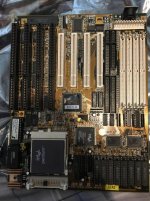Zippy Zapp
Experienced Member
Hi,
I found this motherboard at a local thrift store for $3. I have no idea if it works yet because I haven't had a chance to throw some RAM in it and a video card and hook it up. It seems to have a Pentium 90 CPU installed with no heatsink which makes me a little leery about heat. I have a cooler with sink and fan I can put on it. I also have an AT Power supply to test it with and a ISA VGA card. I don't think I have any PCI VGA cards.
It seems to be a model 5TA2 and I found this link that seems to match:
http://stason.org/TULARC/pc/motherboards/S/SOYO-COMPUTER-CO-LTD-Pentium-SY-5TA2-SY-5TA5.html
My questions boil dow tow:
1. Compatible RAM
2. Cache RAM and Sockets
3. VRM Socket
3. Available PDF of the manual
1. I wanted to make sure I had the correct SIMMs before I installed them. I have 32MB 8x32 EDO which should work but the specs on the link above show 8x36 which I am pretty sure is parity. I would be surprised if this was required.
2. Cache appears to be 256k. They don't use all the pins in the socket and I seem to recall this was ok because other Cache SRAMs were probably compatible that had more pins.
3. What is the VRM socket used for? I don't recall seeing this on the other 286 - 486 systems I built.
4. Does anyone have any available PDF or manual scans of this model?
Any insights or help would be appreciated.
I found this motherboard at a local thrift store for $3. I have no idea if it works yet because I haven't had a chance to throw some RAM in it and a video card and hook it up. It seems to have a Pentium 90 CPU installed with no heatsink which makes me a little leery about heat. I have a cooler with sink and fan I can put on it. I also have an AT Power supply to test it with and a ISA VGA card. I don't think I have any PCI VGA cards.
It seems to be a model 5TA2 and I found this link that seems to match:
http://stason.org/TULARC/pc/motherboards/S/SOYO-COMPUTER-CO-LTD-Pentium-SY-5TA2-SY-5TA5.html
My questions boil dow tow:
1. Compatible RAM
2. Cache RAM and Sockets
3. VRM Socket
3. Available PDF of the manual
1. I wanted to make sure I had the correct SIMMs before I installed them. I have 32MB 8x32 EDO which should work but the specs on the link above show 8x36 which I am pretty sure is parity. I would be surprised if this was required.
2. Cache appears to be 256k. They don't use all the pins in the socket and I seem to recall this was ok because other Cache SRAMs were probably compatible that had more pins.
3. What is the VRM socket used for? I don't recall seeing this on the other 286 - 486 systems I built.
4. Does anyone have any available PDF or manual scans of this model?
Any insights or help would be appreciated.

